Monday 19th April 2021
Fire Exit Regulations
Here’s a list of things you need to know about fire exits based on questions raised by customers and answered by fire safety professionals in our fire safety forum.
In this article we refer to FINAL fire exits when we mention fire exits or fire exit doors.
1. Is any door leading to the outside potentially a fire exit, including your normal entrance?
Not all doors leading to the outside can be used as a fire exit, sliding or revolving doors must not be used for exits specifically intended to be used as fire exits. Doors leading to enclosed courtyards might also not be suitable as fire exits.
In the event of a fire it must be possible for staff and visitors to evacuate your premises as quickly and as safely as possible. This is often through the door by which your staff or the public entered. However, additional fire exits will often be installed to reduce the escape distance or to provide an alternative exit in case the main entry/exit is blocked by fire.
2. Can final fire exit doors be left open?
Security may be a separate issue, but it is completely acceptable to have final fire exit doors standing open. The only time that this should not happen is if the final fire escape door is also acting as a fire-resistant door – although this would be very rare. The issue of fire exit doors left standing open is getting regularly confused with the issue of internal fire doors which must only be held open with a fire door retainer and have a door closer fitted.
3. Must fire exits be easily opened from inside the building?
Fire exit doors must not be locked or fastened in a way that prevents them from being easily and immediately opened from the inside in an emergency. There are a variety of ways to secure fire exit doors in this way:
Panic bars
Also called push bars or crash bars, these are used where large numbers of people are attempting to travel at speed through a fire exit, as minimal pressure on the bar releases the locking mechanism.
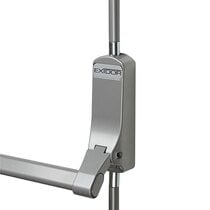
- Single door panic bar with vertical bolt (two point locking)
- Non-handed - suitable for left and right-handed doors
- Suitable for final exit doors in private and public buildings
- Manufactured in the UK with a 10 year warranty
Emergency push pads
Emergency push pads are similar to push bars but feature a small pad as opposed to a horizontal bar. They should only be used where a panic situation is unlikely to arise in an emergency evacuation scenario e.g. when only staff familiar with the building and not members of the general public are using the exit.
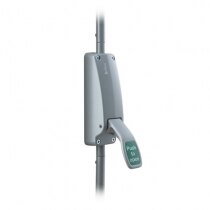
- Fire exit push pad with vertical bolt (two point locking)
- Suitable for left and right-handed doors
- Suitable for non-public use buildings
- 5 year manufacturer's warranty
Redlam panic bolt
This is designed for emergency doors which are not in normal everyday use and should only be opened for maintenance and testing. The bolt is NOT suitable for public areas.
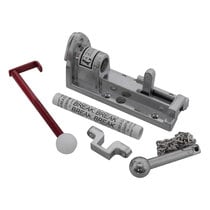
- Secures a final fire exit door from unauthorised use
- When the Ceramtube is broken the panic bolt slides back and unlocks the door
- Suitable for emergency exit hardware for commercial buildings
- Does not jeopardise escape in the event of emergency
- Please note: NOT suitable for public area installations
Kingpin emergency bolt
This is similar to the Redlam bolt; when the handle is pulled, the Kingpin breaks into two pieces, allowing the spring-loaded bolt to retract and thus release the door. The door can, at all times, be used for non-emergency purposes by a key holder. Again, this bolt is not suitable for areas used by the general public.
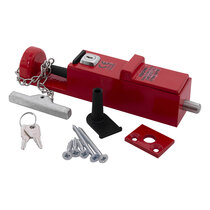
- The door can still be used in a non-emergency by the key holder
- Pulling the handle releases the bolt for emergency escape
- Secures single fire exit doors
- Options for internal and external doors
Maglock
Short for magnetic lock, this holds the door shut using an electromagnetic force between a magnet and a steel plate. Typically maglocks can have a keypad for access from outside and a green quick release button inside for use in an emergency. These systems can be wired into alarm systems that automatically release if the fire alarm system activates or the power supply fails.
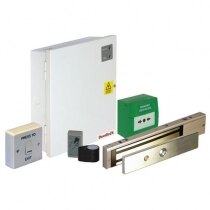
- Door is secured with an electromagnetic lock
- Building access is controlled through a proximity reader
- Suitable for outward opening single doors
- Includes an exit button and emergency manual call point
4. Should fire exit doors always be unlocked whilst a building is in use?
Fire exit doors must not be locked with a key or padlock whilst a building is in use. However, when a building is unoccupied it can be locked as securely as required. If drastic security measures like chains, padlocks or steel bars are required, the first person entering the building in the morning must remove all of these.
It is generally recommended to create a wall mounted board containing the shapes of the security devices used (e.g. padlock) on which each item can be hung. This acts as a visual aid to stop staff forgetting that doors are still locked.
Forgetting to unlock security devices could lead to severe prosecution. We would therefore recommend to only use proper panic bars, etc. These can offer excellent security and allow safe escape in case of an emergency.
5. Can fire exit doors be any colour?
Yes, fire exit doors can be any colour. The important thing is that the exit doors are clearly signed.
6. Should fire exit doors open in the direction of escape?
Yes, fire exit doors should open in the direction of escape. However, in the workplace it may be permissible to have an exit door opening inwards if it is providing excess for less than 60 staff without public access.
7. Does the number of people using a building increase the number of fire exits that are required?
Yes, the more people that use a building will affect the number of fire exits required. The width of the fire exit is also influenced by this. For example, the minimum width of a fire escape catering for up to 60 people is 750mm. For full details of width requirements and the number of exits required, please see the Building Regulations section of the UK Government’s Planning Portal. See also our fire exit help and information page.
8. Must emergency routes and fire exits be indicated by signs?
Fire exit routes need to be marked clearly with emergency exit signs and have to be sufficiently lit, even when the electric power supply has failed. Therefore, emergency routes and fire exits usually require emergency lighting of adequate intensity. Final fire exits can be illuminated themselves or externally lit by an emergency light.
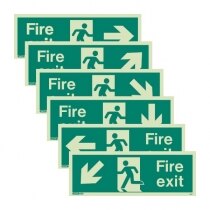
- Rigid plastic for wall mounting
- Photoluminescent (glow-in-the-dark)
- Available in 3 different sizes
9. Must emergency routes and fire exits be kept clear of obstruction?
Final fire exit doors should never be blocked from the inside or outside. Equally, the internal escape routes must not be blocked. Combustible items that could catch alight can act as a fuel source for a fire and could increase the spread of a fire. These items should not be kept on corridors, stairways or circulation spaces. Such items include portable heaters (bottled gas or electric radiant heaters) and gas cylinders.
10. If the fire exit leads onto a road or car park, is a “No Parking” sign required?
It is important that the exit route is kept clear at all times. A ‘No Parking’ sign may be needed to prevent cars from parking directly in front of the final fire exit door. Additionally, a barrier could also be put in place.
More Information
View our related help guides for more information on fire exits and doors.
